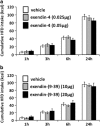Glucagon-like Peptide-1 receptor signaling in the lateral parabrachial nucleus contributes to the control of food intake and motivation to feed
- PMID: 24681814
- PMCID: PMC4104342
- DOI: 10.1038/npp.2014.74
Glucagon-like Peptide-1 receptor signaling in the lateral parabrachial nucleus contributes to the control of food intake and motivation to feed
Abstract
Central glucagon-like peptide-1 receptor (GLP-1R) activation reduces food intake and the motivation to work for food, but the neurons and circuits mediating these effects are not fully understood. Although lateral parabrachial nucleus (lPBN) neurons are implicated in the control of food intake and reward, the specific role of GLP-1R-expressing lPBN neurons is unexplored. Here, neuroanatomical tracing, immunohistochemical, and behavioral/pharmacological techniques are used to test the hypothesis that lPBN neurons contribute to the anorexic effect of central GLP-1R activation. Results indicate that GLP-1-producing neurons in the nucleus tractus solitarius project monosynaptically to the lPBN, providing a potential endogenous mechanism by which lPBN GLP-1R signaling may exert effects on food intake control. Pharmacological activation of GLP-1R in the lPBN reduced food intake, and conversely, antagonism of GLP-1R in the lPBN increased food intake. In addition, lPBN GLP-1R activation reduced the motivation to work for food under a progressive ratio schedule of reinforcement. Taken together, these data establish the lPBN as a novel site of action for GLP-1R-mediated control of food intake and reward.
Figures







References
-
- Astrup A, Rossner S, Van Gaal L, Rissanen A, Niskanen L, Al Hakim M, et al. Effects of liraglutide in the treatment of obesity: a randomised, double-blind, placebo-controlled study. Lancet. 2009;374:1606–1616. - PubMed
-
- Baird JP, Travers JB, Travers SP. Parametric analysis of gastric distension responses in the parabrachial nucleus. Am J Physiol Regul Integr Comp Physiol. 2001;281:R1568–R1580. - PubMed
-
- Blessing WW. The Lower Brainstem and Bodily Homeostasis. Oxford University Press: New York, NY; 1997.
Publication types
MeSH terms
Substances
Grants and funding
LinkOut - more resources
Full Text Sources
Other Literature Sources
Medical

